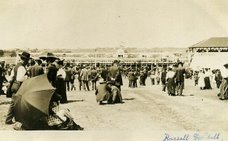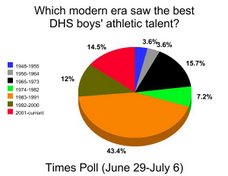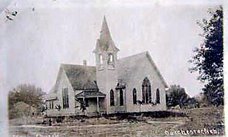
Today we look back at some of the early churches of the Dorchester area community.
According to the 1981 Dorchester Centennial history book, religion played a vital role in the lives of the people who settled Nebraska, just as it does today.
In the early 1870s, a small group of German immigrants who settled northeast of Dorchester formed the first organized church, an Evangelical congregation. Soon after, other rural churches appeared in the Dorchester area countryside, including churches of Methodist, Christian and Congregational denominations.
 In the fall of 1872, Rev. W.D. Gage moved to Dorchester from Nebraska City. He conducted services in the old frame school house, which was the only public building in town. Meanwhile, in the West Blue Area northeast of town, a growing Evangelical congregation attended services in a log home until 1875, when a small church was erected for $450.
In the fall of 1872, Rev. W.D. Gage moved to Dorchester from Nebraska City. He conducted services in the old frame school house, which was the only public building in town. Meanwhile, in the West Blue Area northeast of town, a growing Evangelical congregation attended services in a log home until 1875, when a small church was erected for $450.
The first church building located in Dorchester limits was built in 1879 with the construction of the Congregational Church. It stood one block north and one block west of the present-day post office.
In 1880, the Methodist Church building came to Dorchester after town residents went to Pleasant Hill and tore down the structure and hauled it back by wagon.
 The Dorchester Methodist minister at that time, Rev. John Armstrong, was "a spirited man" according to accounts and did not mind controversy. In fact, he was also an attorney whose clients included two saloon keepers in Dorchester, considered by some to be a "city of rum."
The Dorchester Methodist minister at that time, Rev. John Armstrong, was "a spirited man" according to accounts and did not mind controversy. In fact, he was also an attorney whose clients included two saloon keepers in Dorchester, considered by some to be a "city of rum."
 The Dorchester Methodist minister at that time, Rev. John Armstrong, was "a spirited man" according to accounts and did not mind controversy. In fact, he was also an attorney whose clients included two saloon keepers in Dorchester, considered by some to be a "city of rum."
The Dorchester Methodist minister at that time, Rev. John Armstrong, was "a spirited man" according to accounts and did not mind controversy. In fact, he was also an attorney whose clients included two saloon keepers in Dorchester, considered by some to be a "city of rum."
As Dorchester's population increased in the 1880s, more rural churches appeared in the area, including two churches southwest of town (both United Brethren) and one northwest of town (Evangelical).
 Another local denomination was the "Dunkards," who apparently had no permanent house of worship. According to The Dorchester Star, the Dunkards baptized converts in Turkey Creek.
Another local denomination was the "Dunkards," who apparently had no permanent house of worship. According to The Dorchester Star, the Dunkards baptized converts in Turkey Creek.
By 1884, an area Baptist group had formed and they went on to build the First Baptist Church of Dorchester (pictured).
By the turn of the 20th century, local churches had becoming stronger and more organized due to more population stability and financial prosperity. In 1904, a new Methodist Church was built (pictured at top right). The building would serve the needs of the community until the turn of the next century, when the current Dorchester Methodist Church was built in the 1990s.
.jpg) Also in 1904, a new parsonage was erected for the West Blue Church northeast of town (pictured). In 1908, the Christian congregation also built a new church in town (pictured). It included a tank behind the alter, since the members of the Christian Church practiced total immersion for baptism. Previously, baptism had been held at Turkey Creek or the Blue River.
Also in 1904, a new parsonage was erected for the West Blue Church northeast of town (pictured). In 1908, the Christian congregation also built a new church in town (pictured). It included a tank behind the alter, since the members of the Christian Church practiced total immersion for baptism. Previously, baptism had been held at Turkey Creek or the Blue River.By the late 1910s and early 1920s, the rural churches found it difficult to keep their doors open, as people were no longer restricted to their own small rural neighborhoods, thanks to automobiles and better roads.
Times readers have reminded us that there was a United Missionary Church in the northeast section of town (in the brick building that has served as an apartment for decades now). Raymond Butterfield was the pastor and lived in the parsonage next door. After Butterfield moved to Lincoln, Ralph Strom was pastor.
Looking back more than a century ago, examining Dorchester's earliest years, it becomes clear that while many of the area's first settlers had few possessions, they carried a devout faith. Such spirituality not only provided comfort and hope in uncertain times, it served as a unifying force that solidified the bond between neighbors -- in town and country.


















































A bit of trivia: Early records say the first church in Dorchester was Congregational. They built and used the building that later became Baptist, as per your photo (p. 94, Dorchester History Book). That building was next purchased by Volland for a mortuary, then rebuild as a home for Chas. Britton, the mortitian and his bride. Next it became the home of Mr. & Mrs. James Clark (of the Citizens Bank.) History Buff
ReplyDeleteOops!It wasn't Volland that bought the Baptist Church building for a mortuary... It was Troyer Furniture, who were also the town morticians at that time. The bride of Chas. Britton, the mortitian, was a daughter of Troyer. Sorry for the misinformation. History Buff
ReplyDeleteThis is the best site on the web!
ReplyDeleteNot just saline county or the surrounding lincoln metro. On the entire web. Love it! Keep it up.
-JB from Milford
There was a United Missionary Church in town for some time, also. Went there. It was a brick building in the northeast part of town. Believe it's an apartment building now. Raymond Butterfield was the pastor who lived in the parsonage next door.
ReplyDeleteI went there also. After Butterfield moved to Lincoln, Ralph Strom was pastor. The Leach family were leaders in that church as I recall. I remember Virginia Leach as well as Lether Rardin. A long time ago!
DeleteThe Old UMC Church is just east of Colonel Thompson's house, which my sister is currently restoring!
ReplyDeleteCool history ... and I'm so glad to see Col Thompson's house getting restored!!!!
ReplyDeleteOur family lived in the West Blue Church parsonage from 1967-Dec 1969. It was big beautiful house.
ReplyDeleteThe church in the NE end of town was Thompsons grocery store, & barber shop long before it ever became a church, with a harness shop in the north end and horse barn directly N of it.
ReplyDeleteThe Christian church, was built in 1908. When I was a very young boy the church was closed. My parents purchased the parsonage which was just west of the church. I think they paid $700 for the house. They later purchased the church property. The church building was purchased by a farmer south of town. He tore it down and used the materials to build a house. The church was a really nice building. In 1957 my parents built a new house where the the church used to set. This church was located two blocks West of the high school. It was one block east of where Jerry Sehnert lives today. Roger Schmidt
ReplyDeleteOne of the Evangelical United Brethren churches stood on the northeast corner of the intersection of Co. Rd. 1300 and GG, just south of the new Turkey Creek bridge. I was told this information by an old neighbor when we were newlyweds nearly fifty years ago and I have seen old maps of Saline County that depict that corner as being owned by EUB.
ReplyDelete